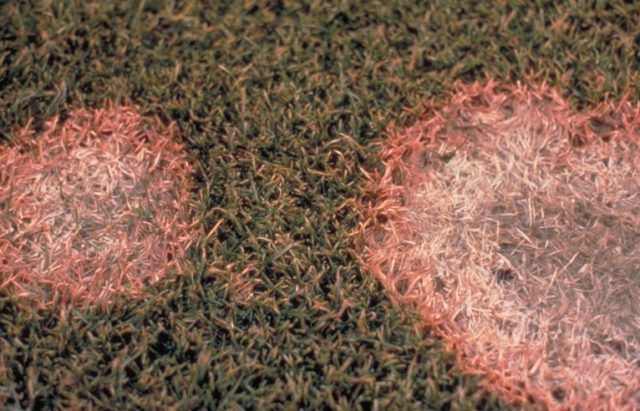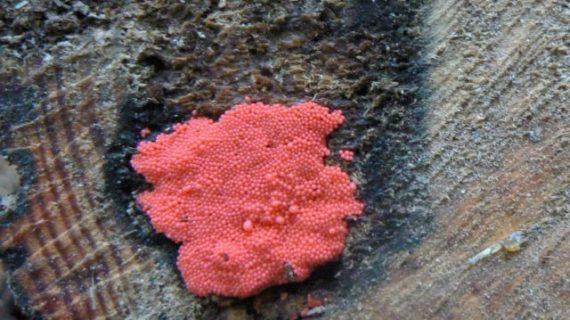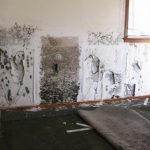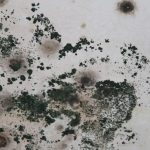Pink is not always a pleasant color, especially if it signifies serious health hazard. Pink mold is actually a common name for bacterial growth that sports pink color.
Just like any other “actual” mold (fungi), pink mold can cause health risks, especially for the most vulnerable groups of people.
Here is what you need to know about this mold, from the physical characteristics, health risks, to removal methods.
What is Pink Mold?
There are several bacteria species that have pink color when growing. Aureobasidium and Fusarium are the most common types of fungi that people often call “pink mold”.
When the bacteria grow and spread, the growth may look fuzzy, like small fibers. Depending on the habitat condition, this pink growth may be accompanied by actual molds, such as gray or white mold.
Since “pink mold” is actually bacteria colony, it can appear in various shapes. You may see it as a slimy layer or pink spots, depending on the level of infestation.
If pink mold grows on food, it may look fuzzy and accompanied with other mold colors, such as gray or green mold.
This type of mold is no way similar to other types of common molds such as black mold or green mold, simply because the first is actually bacteria. However, the pink mold must also be taken serious, since it poses health risks for people.
Some of the risks include:
- Allergic reactions (coughing, sneezing, rash)
- Pneumonia and bronchitis
- Urinary tract infection
- Respiratory tract infection
- Gastrointestinal ailments (stomachache, nausea, diarrhea)
- Bladder ailment and infection
- Poisoning (happens when someone eats food with pink mold)
The most fragile groups of people that may be affected by pink mold are babies, children, elderly people. People with compromised immune system might get affected as well. Therefore, the pink mold must receive your attention just as much as other types of mold.
Pink Mold in Shower and Bathroom

Bathroom, shower, wet toilet, and other perpetually-moist places are ideal habitats for the growth of pink mold. Toilet and bathroom are favorite habitats for bacteria. There is a large amount of filth and other “dirty” particles that bacteria love.
Pink mold usually starts as little specks in the bathroom, but they can develop into disgusting growth when neglected.
The pink mold may appear in any spots in the bathroom, but the most common locations for it to grow are in the tub, sink (and under it). Even we can find around the ventilation and insulation, near the sinkhole, and on shower curtain or walls.
If you have fabric in the bathroom, such as carpet or floor mat, they can also become a fertile place for bacteria to grow.
If you neglect to pay attention to pink mold, you will get exposed to various health risks, especially if your health is already compromised.
Also, if the mold/bacteria problem gets too severe, you may end up replacing bathroom parts such as the tiles or walls, which will cost extra money.
Pink Mold on Food and Cheese
Foods, especially bread and dairy products such as cheese and yogurt, are other ideal habitats for bacteria. Pink mold can grow on the surface of these foods, spoiling them and ruining your dinner plan.
There are bacteria that grow even if you store the foods in the refrigerator. There are many cases where people cut a piece of cheese that looks good, and find pink mold growing inside it.
Dairy products, meat, and bread are especially prone to bacteria activity, because they contain nutrients that bacteria love. They also have short shelf life, which is bad if you often let foods uneaten for a long period.
Overstocked fridge that cannot store foods well because of compromised temperature can also cause bacteria to grow.
Some people think that eating food with pink mold is okay, as long as they do not eat the moldy part.
This is a dangerous misconception, because pink mold is actually bacteria, and eating moldy food can mean ingesting a dangerous amount of bacteria.
The best thing to do is getting rid of foods that already have mold on the surface, including pink mold.
How to Get Rid of Pink Mold
The easiest way to prevent pink mold from growing is by preventing your bathroom or refrigerator from becoming ideal bacteria habitat. Here is what you can do:
- Prevent moisture buildup and product stain
Moisture build up and stain from shampoo or soap create an ideal habitat for bacteria. You can prevent it by installing a fan in the bathroom, and wipe the sink or tub as often as possible. Clean the bathroom regularly to keep it clean and mold-free.
- Prevent all leakage
Check regularly if you have plumbing or leakage problem. If you find signs of such problems, do not wait to repair them. A delayed repair will cost you more when the mold and bacteria grow.
-
Do not install carpet
Carpet in a bathroom will soak up the moisture and hard to dry, resulting in mold and even bacteria growing. If you want to install extra layer in a bathroom, a throwaway rug is better because you can dry it outside when wet.
- Make sure your fridge is cold
To prevent pink mold growing on food, make sure your fridge condition is on top. Also, do not store hot or warm food immediately in the fridge, since it will become an ideal habitat for bacteria.
Wait until the food reaches room temperature before you store it in the fridge.
If you see the first signs of pink mold in the bathroom, you can immediately clean it using detergent and water. If the problem is a little more serious, use a bleach solution or bathroom cleaning product with disinfectant.
If the problem is serious, it is better to call professional service. Do not forget to use goggles and gloves when scrubbing pink mold from your bathroom surface.
Pink mold is often confused with actual fungi, but it is as dangerous as other types of mold, since it is actually the growth of bacteria.
Make sure to keep your bathroom dry and your fridge cold to keep bacteria from growing, and clean all possible risks of pink mold as soon as possible.







Hi we install shower screens and have been having this problem with pink colour on the plastic vinyl. It is impossible to remove so we have to replace all affected vinyl. Is there anyway to treat the plastic to remove the pink stain?
Spray the pink with a mixture of 1part bleach to 3parts water. Works for me
I am in an apartment, I started feeling very tired then developed strange rashes. It is even on my eyelids and looks like I am some sort of meth addict. I use zero drugs. I clean the apartment aggressively. I run tower fans, and open my Windows. The apartment does not have air conditioner or ceiling fans. It is halfway underground as well. Mold grows on our food within days, the bathrooms have to be cleaned every three days as they mold quickly. I found mold on the bottom of the walls in the closet. I wipe our countertops in the kitchen at least once a day. Pink mold gets in the bathrooms quickly. What I find troubling the most is that everyday when I wipe the counters down with a strong Pine-sol solution, or a bleach, I find a strange pink residue all over the cloth. I wipe it down a few times until the residue it gone but the very next day it is back. I feel like I am overrun at this point.It is becoming a fight for my health. I am 27 and have not ever had allergies like this. I have to clean our home like I have a severe case of OCD. I really have no idea what else to do. I am currently residing in Oregon. The apartment has poor lightening as well. It is like they built the apartment specifically for cultivating mold.
Natasha,
If you haven’t already done so, you need to consider moving out IMMEDIATELY! The health symptoms you are describing can ALL absolutely be caused by exposure to mold and/or the mycotoxins that spread from the mold. Exposure to mycotoxins is a serious health risk, and can be life-threatening or even fatal. Our 14-year-old daughter almost died from living in a mold-infested room (the mold was all growing under the wood floor in her bedroom only, and could not be seen; but the mycotoxins (microscopic mold spores) were present everywhere in our 4600 sq ft home), and she still to this day, almost 1o years later, suffers from all kinds of mold-related health issues. During the mold exposure, she was hospitalized in isolation, and had to have neupogen shots in each arm twice a day to try to jump-start her bone marrow, which had shut down completely from the exposure to the toxins. Mold is not something to mess around with!
You can break your lease and move out, but I would suggest that you make the apartment complex do a COMPLETE remediation on the entire apartment AND its contents. Anything that you own that is in that apartment will have mycotoxins on/in it, and you will only be moving the problem with you if you move all of your contaminated belongings (including clothes, furniture, EVERYTHING!!!) to your new residence.
Please, do yourself a huge favor and get out of that apartment NOW!
Natasha, Many years ago my friend Susan rented a basement apartment. Not long after moving in she developed Asthma like breathing difficulties and skin rashes, itchy eyes, congestion and allergic reactions to her cat and dog. It was puzzling because she had never had these problems before. Susan began asking people in her neighborhood about the building she lived in. Her apartment was charming, appeared clean and was freshly painted, tiled and carpeted, it looked fine. What she learned was that it had flooded from a nearby river and was completely redone. Unfortunately the work wasn’t done by experienced contractors, the owner and some hired casual laborers had done the work. Essentially it was a cover-up remodel and the unaddressed moisture issues became a big mold problem. Sadly my friend never became allergy free, and still suffers the consequences of having lived in a mold infested home. When she figured out what had caused her illness she asked her landlord to release her from the lease. It was close to the one year term and they wouldn’t let her out of it. She consulted a lawyer but the cost of legally pursuing it versus moving to a new place while finishing out the lease at the contaminated apartment, but not living there for the last three months is what she did. Susan was attending graduate school as this disaster unfolded, she also worked. Doing both and having some kind of life was really all there was time for, she really didnt have enough time or energy to dedicate to resolving the problem, the landlord got away with doing nothing to make things right. I think you need to get out of your moldy apartment and i hope you have better luck doing it, with as little expense to you as possible. Consult your local housing authority and perhaps your health dept, they may offer some solid and helpful advise. Best of luck to you on resolving this and moving into a safe healthy place.